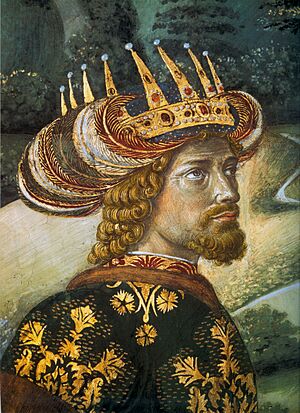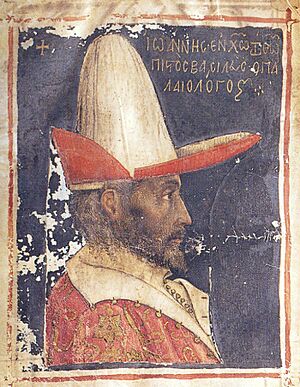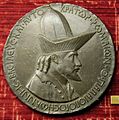John VIII Palaiologos facts for kids
Quick facts for kids John VIII Palaiologos |
|
|---|---|
| Emperor and Autocrat of the Romans | |

A detail from a painting by Benozzo Gozzoli (1459–1461). Many believe it shows John VIII.
|
|
| Byzantine emperor | |
| Reign | 21 July 1425 – 31 October 1448 |
| Coronation | 19 January 1421 |
| Predecessor | Manuel II Palaiologos |
| Successor | Constantine XI Palaiologos |
| Proclamation | c. 1407 as co-emperor |
| Born | 18 December 1392 |
| Died | 31 October 1448 (aged 55) |
| Spouse |
Anna of Moscow
(m. 1414; died 1417)Sophia of Montferrat
(1421–1426)Maria of Trebizond
(m. 1427; died 1439) |
| Dynasty | Palaiologos |
| Father | Manuel II Palaiologos |
| Mother | Helena Dragaš |
| Religion | Eastern Catholic Previously Eastern Orthodox |
John VIII Palaiologos (born December 18, 1392 – died October 31, 1448) was the second-to-last Byzantine emperor. He ruled from 1425 to 1448. During his time, he tried to bring the Orthodox and Catholic churches back together. He also worked hard to protect his capital city, Constantinople, from the growing Ottoman Empire. His brother, Constantine XI, became emperor after him.
Contents
Life of John VIII Palaiologos
John VIII was the oldest son of Manuel II Palaiologos and Helena Dragaš. Helena was the daughter of a Serbian prince. John started ruling alongside his father before 1416. He became the sole emperor on July 1, 1425. However, he had already taken full control on January 19, 1421.
Protecting Constantinople
In June 1422, John VIII Palaiologos helped defend Constantinople. The city was under attack by Murad II of the Ottoman Empire. Sadly, he had to accept the loss of Thessaloniki. His brother, Andronikos, had given this city to Venice in 1423.
Journeys to Italy
To get help against the Ottomans, John traveled to Italy twice. These trips were in 1423 and 1439. During his second trip, he met Pope Eugene IV in Ferrara. There, he agreed to unite the Greek and Roman churches.
The Council of Florence
This union was officially agreed upon at the Council of Florence in 1439. John attended this important meeting. He brought about 700 people with him. This group included Patriarch Joseph II of Constantinople and George Gemistos Plethon. Plethon was a famous philosopher.
However, the union did not last. Many people in Constantinople were against it. Even so, John's smart actions helped keep the city safe from the Ottoman Empire.
Succession and Death
John VIII Palaiologos chose his brother, Constantine XI, as his successor. Constantine had served as a leader in Constantinople from 1437 to 1439. Even though his younger brother, Demetrios Palaiologos, tried to cause problems, their mother Helena made sure Constantine XI became emperor in 1448.
John VIII died in Constantinople in 1448. He was the last Byzantine emperor to die of natural causes. He was buried in the Pantokrator Monastery.
Marriages
John VIII Palaiologos was married three times. His first marriage was in 1414 to Anna of Moscow. She was the daughter of Grand Prince Basil I of Moscow. Anna died in August 1417 from a disease called plague.
His second marriage was in 1421 to Sophia of Montferrat. This marriage was arranged by his father and Pope Martin V.
His third marriage was in 1427 to Maria of Trebizond. This marriage was arranged by a future cardinal named Bessarion. Maria died in the winter of 1439, also from plague. John VIII did not have any children from any of his marriages.
Representation in Art
Many artists painted John VIII Palaiologos when he visited Italy. One of the most famous paintings is by Benozzo Gozzoli. It is on a wall in the Magi Chapel in Palazzo Medici-Riccardi in Florence. Some people also believe John VIII is shown in Piero della Francesca's painting, Flagellation. A
portrait of John also appears in a old book at the Saint Catherine's Monastery in the Sinai Peninsula.
Gallery
-
Portrait of John VIII Palaiologos from a manuscript at Saint Catherine's Monastery c. 1440
-
Medal of the Emperor John VIII Palaiologos during his visit to Florence, by Pisanello (1438). The words on it are in Greek.
-
Sketches of John VIII Palaiologos during his visit at the Council of Florence in 1438, by Pisanello
-
Piero della Francesca's Flagellation, possibly showing John VIII Palaiologos as Pontius Pilatus (the figure on the far left)
See also
 In Spanish: Juan VIII Paleólogo para niños
In Spanish: Juan VIII Paleólogo para niños








